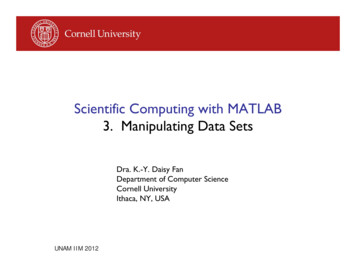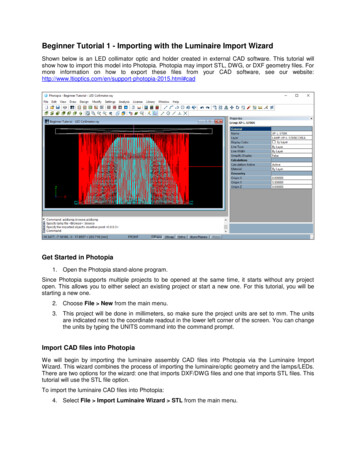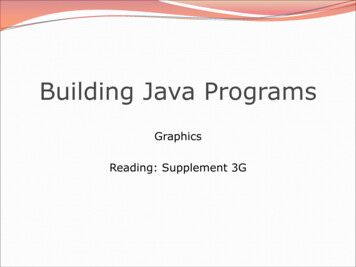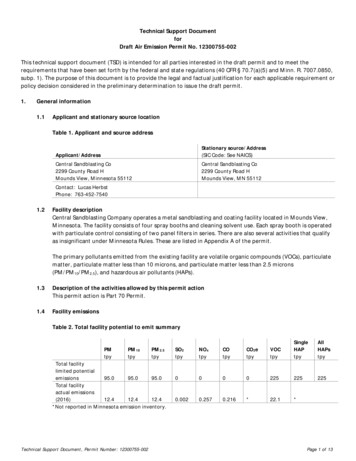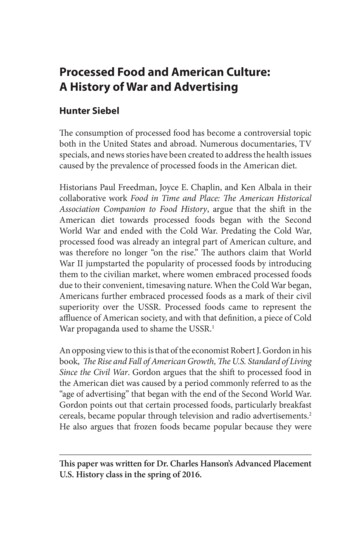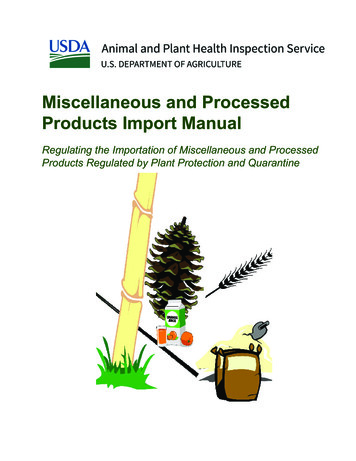
Transcription
Miscellaneous and ProcessedProducts Import ManualRegulating the Importation of Miscellaneous and ProcessedProducts Regulated by Plant Protection and Quarantine
Some processes, equipment, and materials described in this manual may be patented. Inclusion in thismanual does not constitute permission for use from the patent owner. The use of any patented invention inthe performance of the processes described in this manual is solely the responsibility of the user. APHISdoes not indemnify the user against liability for patent infringement and will not be liable to the user or to anythird party for patent infringement.The U.S. Department of Agriculture (USDA) prohibits discrimination in all its programs and activities on thebasis of race, color, national origin, age, disability, and where applicable, sex, marital status, familial status,parental status, religion, sexual orientation, genetic information, political beliefs, reprisal, or because all orpart of any individual’s income is derived from any public assistance program. (Not all prohibited basesapply to all programs). Persons with disabilities who require alternative means for communication ofprogram information (Braille, large print, audiotape, etc.) should contact USDA’s TARGET Center at (202)720-2600 (voice and TDD). To file a complaint of discrimination, write to USDA, Director, Office of CivilRights, 1400 Independence Avenue, SW., Washington, DC 20250-9410, or call (800) 795-3272 (voice) or(202) 720-6382 (TDD). USDA is an equal opportunity provider and employer.When using pesticides, read and follow all label instructions.First Edition Issued 2014
ContentsMiscellaneousand uresReference1-12-13-1Appendix AList of Trees and ClassificationsAppendix BWheat Kernel Job iscellaneous and Processed Products ManualTOC-1
TOC-2Miscellaneous and Processed Products Manual02/2017-47
FiguresMiscellaneousand ProcessedFigure 2-1Figure 2-2Figure 2-3Figure 2-4Figure 3-1Figure 3-2Figure 3-3Figure 3-4Figure B-1Figure B-211/2016-16Inspection Process 2-2Softwood Firewood Heat Treatment Certificate Using a KilnFacility 2-23Hardwood Firewood Heat Treatment Certificate Using a KilnFacility 2-24Spruce Logs Heat Treatment Certificate Using a KilnFacility 2-25Formula for Computing Density of a Package or Bale of RiceStraw 3-35IPPC ISPM 15 Mark 3-144DoD “Pest-Free” Certification Mark 3-144Map of CFR-Defined Area 3-151Depiction of Wheat Kernel with Intact Brush Hairs On Its Terminal End B-3Example of Wheat Kernels with Intact Brush Hairs On Their Terminal Ends B-4Miscellaneous and Processed Products ManualLOF-1
FiguresLOF-2Miscellaneous and Processed Products Manual11/2016-16
TablesMiscellaneousand ProcessedTable 1-1Table 1-2Table 2-1Table 2-2Table 2-3Table 2-4Table 2-5Table 2-6Table 2-7Table 2-8Table 2-9Table 3-1Table 3-2Table 3-3Table 3-4Table 3-5Table 3-6Table 3-7Table 3-8Table 3-9Table 3-10Table 3-11Table 3-12Table 3-13Table 3-14Table 3-15Table 3-1606/2022-148How to Use Decision Tables 1-7Reporting Issues With or Suggestions for the Miscellaneous andProcessed Products Import Manual 1-10Steps for Sampling Basmati Rice 2-7Determining Regulatory Action Based on Hull Count 2-8Determining Sample Size for Bagged Cargo 2-9Approved Companies for Admissible Dried, Ornamental PlantMaterial 2-12Sample Size for Dried, Ornamental Plant Material 2-13Certification Associated with Grapevines 2-13Determine Whether the Vehicle is Precleared 2-18Selecting Screen Size 2-20Diameters of the Pores of U.S. Standard Screens (NOT part ofthe job aid) 2-21Imports Suspected of Being Controlled Substances 3-3Methods of Commercial Processing with Resultant Commodities that do NOT REMAIN CAPABLE of Being Infested withQuarantine Pests 3-4Methods of Commercial Processing with Resultant Commodities that REMAIN CAPABLE of Being Infested with QuarantinePests 3-6Types of Products Listed in this Reference 3-8Steps for Using this Manual 3-8Reference Tables Locator 3-9Used Bags, Bagging, and Covers 3-11Used Jute or Burlap 3-12Bees, Bee Equipment, and Bee Products Locator 3-13Beekeeping Equipment 3-14Bees from All Origins (dead and intended for importation asspecimens) 3-14Bees from All Origins (alive); Includes Package Bees andQueen Bees with Attendants 3-15Honey Bee Products (including bee bread, beeswax, comb,honey, propolis, and royal jelly) 3-17Broomcorn and Broomstraw Locator 3-19NONCOMMERCIAL Brooms and Other Articles Made or Crafted from Broomcorn or Broomstraw in Passenger Baggage 319COMMERCIAL Brooms and Other Articles Made or Craftedfrom Broomcorn or Broomstraw 3-20Miscellaneous and Processed Products ManualLOT-1
TablesTable 3-17Table 3-18Table 3-19Table 3-20Table 3-21Table 3-22Table 3-23Table 3-24Table 3-25Table 3-26Table 3-27Table 3-28Table 3-29Table 3-30Table 3-31Table 3-32Table 3-33Table 3-34Table 3-35Table 3-36Table 3-37Table 3-38Table 3-39Table 3-40Table 3-41Table 3-42Table 3-43Table 3-44Table 3-45Table 3-46LOT-2COMMERCIAL Brooms and Other Articles Made or Craftedfrom Broomcorn or Broomstraw Destined to Guam orCNMI 3-20COMMERCIAL Brooms and Other Articles Made or Craftedfrom Broomcorn or Broomstraw from Countries OTHER THANCanada or Mexico 3-21Broomcorn or Broomstraw, Commercial Shipments 3-22Cones (seed cones/seed pods) 3-23Used Canadian Origin Containers 3-23Grains Locator 3-24Corn (Zea mays) 3-25Cracked Corn 3-26Cooked Corn 3-26Dried Corn (whole kernels only) 3-27Corn Preserved in Liquid (such as alcohol, brine, oil, syrup, orvinegar) 3-27Cobs, Husks, Shanks, or Silks (including cannery waste) 327Cobs, Husks, Shanks, or Silks (including cannery waste) fromOTHER THAN Canada 3-28Corn Fodder or Stover (stems and leaves) 3-28Corn Fodder or Stover Harvested in a Country OTHER THANCanada 3-29Corn Handicrafts Made from Any Parts of the Plant 3-30Millet and Pseudo-millet 3-31Rice (Oryza spp.) and Its Products 3-32Rice Articles Destined to OTHER THAN Guam or the Commonwealth of the Northern Mariana Islands (CNMI) 3-33Rice Straw or Rice Hulls to be Manufactured at APHIS-approved Sites 3-34Rice Straw or Rice Hulls Imported for Purposes OTHER THANManufacturing 3-34Rice—Articles Made of or Fully Manufactured and Finished fromRice Straw 3-35Rice—Milled Products 3-36Rice—By-products from Rice Milling 3-37Rice—Articles Made or Manufactured from Rice Panicles,Leaves, Hulls, or Seeds, and MAY or May NOT ContainStraw 3-37Wheat (Triticum spp.), Goatgrass (Aegilops spp.), Triticale (Triticum aestivum Secale cereale) and Their products 3-38Wheat Straw (EXCEPT that intended for decoration or as an ingredient in potpourri) 3-38Wheat Straw (EXCEPT that intended for decoration or as an ingredient in potpourri) from Mexico 3-39Wheat Straw for Decoration or Articles Crafted from ANY Part ofthe Wheat Plant 3-40Wheat—Milled Products and By-products (Table 1 of 2) 3-41Miscellaneous and Processed Products Manual06/2022-148
TablesTable 3-47Table 3-48Table 3-49Table 3-50Table 3-51Table 3-52Table 3-53Table 3-54Table 3-55Table 3-56Table 3-57Table 3-58Table 3-59Table 3-60Table 3-61Table 3-62Table 3-63Table 3-64Table 3-65Table 3-66Table 3-67Table 3-68Table 3-69Table 3-70Table 3-71Table 3-72Table 3-73Table 3-74Table 3-75Table 3-76Table 3-77Table 3-78Table 3-79Table 3-80Table 3-81Table 3-82Table 3-83Table 3-84Table 3-8506/2022-148Wheat—Milled Products and By-products (Table 2 of 2) 3-42Grain Screenings and Seed Screenings Locator 3-43Pelleted Screenings 3-43Unpelleted Screenings from Agricultural and VegetableSeeds 3-43Grasses Locator 3-44Bamboo (Bambusoideae) 3-45Grasses (all genera and species of Poaceae EXCLUDING corn,millets, rice, and wheat) stems, leaves, inflorescences, andarrangements 3-45Sugarcane (Saccharum spp.) 3-46Sugarcane—Bagasse, Bagacillo, and Stalk Residue 3-47Sugarcane Products and By-products Including Parts of theSugarcane Plant 3-47Handicraft Locator Table 3-48Handicrafts Containing NO Wood or Wood Products 3-48Wooden Handicrafts 3-49Country of Origin for Wooden Handicrafts 3-49Hay, Fodder, Stover, and Straw (various herbage of plants cutand cured for forage) Locator 3-50Hay, Fodder, Stover, and Straw (various herbage of plants cutand cured for forage) that is NOT a Federal Noxious Weed(FNW) 3-50Herbal Medicines, Extracts, Oils, Ointments, and PowdersLocator 3-52Aloe ferox3-53Aniba roseodora3-54Aquilaria spp.3-55Bletilla striata3-56Bulnesia sarmientoi3-57Cibotium barometz3-58Cistanche deserticola3-58Dendrobium cruentum (dried or processed plant parts) 3-59Dioscorea deltoidea3-60Gastrodia elata3-61Ginseng (Panax ginseng and Panax quinqefolius) 3-62Goldenseal (Hydrastis canadensis) 3-63Guaiacum spp. 3-64Gyrinops spp.3-65Hoodia (Hoodia spp.) 3-66Nardostachys grandiflora3-67Picrorhiza kurrooa3-68Podophyllum hexandrum (dried or processed plant parts) 369Prunus africana3-70Pterocarpus santalinus3-71Rauvolfia serpentia (dried or processed plant parts) 3-71Saussurea costus Saussurea lappa3-73Miscellaneous and Processed Products ManualLOT-3
TablesTable 3-86Table 3-87Table 3-88Table 3-89Table 3-90Table 3-91Table 3-92Table 3-93Table 3-94Table 3-95Table 3-96Table 3-97Table 3-98Table 3-99Table 3-100Table 3-101Table 3-102Table 3-103Table 3-104Table 3-105Table 3-106Table 3-107Table 3-108Table 3-109Table 3-110Table 3-111Table 3-112Table 3-113Table 3-114Table 3-115Table 3-116Table 3-117Table 3-118Table 3-119Table 3-120LOT-4Taxus walliciana (dried or processed plant parts) 3-73Regulating Herbarium Specimens 3-75Herbarium Specimens and Other Preserved PlantMaterials 3-75Herbarium Specimens—Dried and Pressed Plants or PlantParts 3-76Herbarium Specimens—Unpreserved Specimens and ThosePreserved in a Fluid 3-77Insects, Pathogens, and Snails Locator 3-77Insects, Earthworms, Pathogens, and Similar LIVEOrganisms 3-78Snails 3-79Nuts Locator 3-80Acorns 3-80Chestnuts 3-80Peanuts 3-81Packing Material Locator 3-81Packing Material (burlap) 3-82Packing Material (egg cartons, egg crates, egg flats, or eggliners) 3-82Packing Material (forest litter) 3-82Packing Material (soil) 3-82Packing Material (OTHER THAN burlap, egg cartons, eggcrates, egg flats, egg liners, forest litter, or soil) 3-83Processed or Dried Plant Materials Locator 3-84Artichoke (Cynara spp.)—Branches, Inflorescences, andArrangements 3-85Branches—Plant Parts (including decorative branches) but EXCLUDING Seeds 3-85Processed Citrus Peel (ONLY) 3-86Coffee (Coffea spp.) Plant Parts (NOT including roastedbeans) 3-87Cotton (Gossypium spp.) 3-88Cottonseed Products 3-89Cumin, Roasted or Ground (Cuminum cyminum) 3-90Cuscutae (dodder) 3-91Date Palm (Phoenix spp.) Leaves (fronds) and Articles Made orCrafted from the Leaves 3-91Eucalyptus (Eucalyptus spp.) 3-92Grapevine (Vitis spp.) Articles Made, Crafted, or Woven fromGrapevines (wholly or in part) 3-93Guitar, Rosewood, and Other Articles Made from Rosewood(Dalbergia nigra) 3-94Gums (largely from Tropical and Subtropical Species of theLeguminosae) 3-94Hibiscus Inflorescences in Association with Plant Parts 3-95Palm Fronds and Articles Crafted from Them 3-96Parasitic Plants (e.g., mistletoe) 3-97Miscellaneous and Processed Products Manual06/2022-148
TablesTable 3-121Table 3-122Table 3-123Table 3-124Table 3-125Table 3-126Table 3-127Table 3-128Table 3-129Table 3-130Table 3-131Table 3-132Table 3-133Table 3-134Table 3-135Table 3-136Table 3-137Table 3-138Table 3-139Table 3-140Table 3-141Table 3-142Table 3-143Table 3-144Table 3-145Table 3-146Table 3-147Table 3-148Table 3-149Table 3-150Table 3-151Table 3-152Table 3-153Table 3-154Table 3-155Table 3-156Table 3-157Table 3-158Table 3-15906/2022-148Peat (including coco peat), Peat Moss, Peat Tar, Dried Decorative Mosses, and Moss-like Plants 3-97Pomes (apple, pear, and quince) (Malus spp., Pyrus spp., andCydonia spp.) 3-98Potpourri and Potpourri Ingredients 3-98Rainsticks 3-99Tree Ferns (Cyatheaceae and Dicksoniaceae) Stumps, Bark,and Their Products 3-99Vanilla (Vanilla planifolia) 3-100Processed Fruit and Vegetables Locator 3-101COOKED Fruit and Vegetables 3-102Citrus (Rutaceae); NOT Heat Treated, Sterile, Shelf-stable,NOR Sealed; ENTERING the U.S.; AND Destined to OTHERTHAN Guam 3-103DRIED Fruit and Vegetables Locator 3-104Dried Citrus (fruit) 3-105Dried Imperata cylindrica (cogongrass) 3-105Dried Mango 3-105Dried Peppers (Capsicum spp.) 3-106Dried Potatoes 3-106Fresh, Cut Fruit Tables Locator 3-107Fresh, Cut Fruit Processed in Canada 3-107Fresh, Cut Fruit Processed in Ghana 3-108Fresh, Cut Fruit Processed in Mexico 3-109Fresh, Cut Fruit Processed in the Western Hemisphere 3-110Fresh, Cut Fruit Processed in ANY Country 3-110Fresh, Cut Vegetables Locator 3-112Fresh, Cut Allium spp. (e.g., leeks, garlic, onions, andshallots) 3-112Fresh, Cut Beans (into continental U.S. ports only) 3-113Fresh, Cut Carrots 3-114Fresh, Cut Cassava, Dasheen, Sweet Potato, or Yam (commercial consignment only) 3-114Fresh, Cut Corn 3-115Fresh, Cut Lettuce, Shredded and Entering into a Port of Entrywithin the Continental U.S. 3-115Fresh, Cut Mushrooms, Mushroom Spawn, or MushroomSpores 3-116Fresh, Cut Palm hearts (species of Palmae) 3-116Fresh, Cut Salad Mixes 3-116Soup Mixes Containing Fresh, Cut Vegetables 3-116Frozen Fruit and Vegetables Locator 3-117Frozen Avocado 3-117Frozen Citrus 3-118Frozen Mango 3-119Frozen Palm Heart 3-119Frozen Potato (commercial consignment only) 3-120Fruit and Vegetable Juice, Cooked, Puree, Concentrate,Miscellaneous and Processed Products ManualLOT-5
TablesTable 3-160Table 3-161Table 3-162Table 3-163Table 3-164Table 3-165Table 3-166Table 3-167Table 3-168Table 3-169Table 3-170Table 3-171Table 3-172Table 3-173Table 3-174Table 3-175Table 3-176Table 3-177Table 3-178Table 3-179Table 3-180Table 3-181Table 3-182Table 3-183Table 3-184Table 3-185LOT-6Pickle 3-121Fruit and Vegetables Processed with a Method NOT PreviouslyDescribed Locator Table 3-122Job’s Tears or Adlay Millet and Other Millets 3-122Pomegranate Arils 3-123Processed Seeds Locator 3-124Cucurbit Seeds (Cucurbitaceae) Dried, Roasted, and SaltedSeeds 3-125Seeds (OTHER THAN nuts) that are Processed (seeds withhulls removed) or Manufactured into Articles 3-126Goat Skins, Lamb Skins, and Sheep Skins 3-128Soil and Related Materials Locator 3-129Soil (as such) and Related Materials (including live rock andquarry products) 3-130Soil (as such), Clay, Sand (OTHER THAN clean beach sand,clean desert sand, or clean river sand), or Silt LACKING a Permit or NOT Moving to an Approved Soil Facility 3-131Quarry Products 3-132Dried Teas, Herbal Teas, and Herbal Infusions Locator 3-133Dried Tea, Herbal Tea, Herbal Infusions, and Other Concoctions to be Boiled 3-133Dried Tea, Herbal Tea, Herbal Infusions, and Other Concoctions to be Boiled Made from OTHER THAN Leaves or with ADMISSIBLE Leaves 3-134Dried Tea, Herbal Tea, Herbal Infusions, and Other Concoctions to be Boiled Made from OTHER THAN Flowers or Leavesor with ADMISSIBLE Flowers or Leaves 3-135Dried Tea, Herbal Tea, Herbal Infusions, and Other Concoctions to be Boiled Made from OTHER THAN Bark, Flowers, orLeaves, or with ADMISSIBLE Bark, Flowers, or Leaves 3-137Dried Tea, Herbal Tea, Herbal Infusions, and Other Concoctions to be Boiled Made from OTHER THAN Bark, Flowers, Fruitor Fruit Peel, or Leaves, or with ADMISSIBLE Bark, Flowers,Fruit or Fruit Peel, or Leaves 3-138Dried Tea, Herbal Tea, Herbal Infusions, and Other Concoctions to be Boiled Made from OTHER THAN Bark, Flowers, Fruitor Fruit Peel, Leaves, or Seed, or with ADMISSIBLE Bark, Flowers, Fruit or Fruit Peel, Leaves, or Seed 3-138American Ginseng (Panax quinquefolius) or Goldenseal (Hydrastis canadensis) 3-139Used Vehicles, Farm Machinery, and Farm Tools from AllCountries 3-139Check for CITES Listing 3-140Identify the Product 3-141Check for Permit 3-141Verify that Permit Conditions Are Met 3-142Classify the Product 3-142Bamboo (timber/wood) 3-143Miscellaneous and Processed Products Manual06/2022-148
TablesTable 3-186Table 3-187Table 3-188Table 3-189Table 3-190Table 3-191Table 3-192Table 3-193Table 3-194Table 3-195Table 3-196Table 3-197Table 3-198Table 3-199Table 3-200Table 3-201Table 3-202Table 3-203Table A-1Table A-206/2022-148Regulated Wood Packaging Material (WPM)3-143Maritime Dunnage,3-145Regulated Wood Packaging Material (WPM) NOT U.S. Returned, NOR DoD Sponsored, NOR in Transit, and if of ForeignOrigin, that Origin is OTHER THAN Canada 3-145Regulated Wood Packaging Material (WPM) with ISPM 15 Markand Pests Found 3-146Wood Packaging Material (WPM) LACKING ISPM 15mark 3-147Crates 3-147Wood Packaging Material Associated with BundledLumber 3-147Wood from Canada 3-148Firewood 3-148Wood from Rutaceae Subfamilies or Fraxinus (ash) 3-148Picea spp. Logs 3-149Gypsy Moth Requirements 3-149Wood from an Area of Canada Infested with Gypsy Moth 3149Wood from an Area of Canada NOT Infested with GypsyMoth 3-150All Other Regulated Articles from Canada 3-150Wood from Mexico 3-150Other Regulated Wood and Wood Products 3-150Places in Asia that are East of 60 East Longitude and North ofthe Tropic of Cancer 3-152Categories of Wood and Types of Protection A-1Alphabetical List of Trees by Scientific Name A-1Miscellaneous and Processed Products ManualLOT-7
TablesLOT-8Miscellaneous and Processed Products Manual06/2022-148
Chapter1IntroductionContentsPurpose 1-2Scope 1-2What the Manual Covers 1-2What the Manual Does NOT Cover 1-4Users 1-4Related Documents 1-5Authority 1-5Application 1-6Conventions 1-6Advisories 1-6Boldface 1-6Bullets 1-6Change Bars 1-7Chapter 1-7Contents 1-7Control Data 1-7Decision Tables 1-7Examples 1-8Footnotes 1-8Heading Levels 1-8Hypertext Links (Highlighting) to Tables, Figures, and Headings 1-8Indentions 1-8Italics 1-9Numbering Scheme 1-9Transmittal Number 1-9Using the Manual 1-9Reporting Issues With or Suggestions For the Miscellaneous and ProcessedProducts Import Manual 1-10Manual Updates 1-10Ordering Additional Manuals and Revisions 1-1009/2021-142Miscellaneous and Processed Products Manual1-1
IntroductionPurposePurposeThe Miscellaneous and Processed Products Manual provides the background,procedures, and reference tables for regulating imported processed articles ofplant and nonplant sources (i.e., goatskins, beeswax) that might serve tointroduce exotic pests and parasites.The articles from the countries of origin listed in this manual are regulatedbecause just one destructive pest might be enough to start a pest outbreak thatcan cause millions of dollars of damage to crops, trees, flowers, or lawns. Bytheir destructiveness, pests can increase the price and reduce the quality offood, lower property values, and ruin recreational areas. The extinction of justone plant species does away with the aesthetic, ecological, educational,historical, recreational, commercial, and scientific value of our world.Articles are listed in this manual by their common name. For example, entriesare found under such terms as “kuth roots,” “rice,” “wheat,” and “wood andwood products.” Primarily listing under common name rather than scientificname is due to articles being either manifested or invoiced by their commonname—or they are known in the trade by a common name. If there is only ascientific name, the Index serves as a cross-reference and will send the user tothe appropriate page.ScopeWhat the Manual CoversThe Miscellaneous and Processed Products Manual covers all processedarticles of plant and nonplant sources that could serve to introduce exotic pestsor parasites (e.g., goatskins are entered because they can sustain populations ofthe khapra beetle; while beeswax is entered because it could introduce exoticbee mites or diseases of bees). Specifically, the manual covers: Decorative articles and handicrafts constructed using plants and plantparts Herbarium specimens Nonplant articles that could become contaminated with exotic plant pests,parasites, and/or animal secretions Products that result from the harvesting and milling of field crops—principally corn, cotton, rice, sugarcane, and wheat Products that result from the harvesting, preserving, and processing offruits, herbs, nuts and other seeds, and vegetables1-2Miscellaneous and Processed Products Manual09/2021-142
IntroductionScopeProcessed Plants and Plant PartsIf the article was derived from a plant or plant part and was processed, use thismanual to determine if the article is regulated. “Dried” means the article has had the moisture reduced to preserve it or toextend its shelf life “Processed” means the plant or plant part was prepared, treated, orconverted by being subjected to some physical or chemical procedurebeyond harvestingMiscellaneous Plant ProductsIf the plant or plant part cannot be categorized as: 1) article intended forpropagation; 2) fresh, cut article of the florist trade; 3) fresh fruit or vegetable;nor unprocessed seed including edible nuts, use this manual to determine if thearticle is regulated.Nonplant ArticlesIf the article is goatskins, beeswax, honey, used equipment for keeping bees, orbagging, use this manual to determine if the article is regulated.Examples of Articles Covered in the Miscellaneous and ProcessedProducts ManualSome examples of articles covered in the Miscellaneous and ProcessedProducts Manual are: broomstraw; beehives; fresh, cut fruit and vegetables;and wood products.The manual is divided into the following chapters: Introduction Procedures ReferenceThe manual also includes two appendixes, a glossary, and an index.The Introduction contains basic information about the Miscellaneous andProcessed Products Manual. This chapter includes the manual’s purpose,scope, users, and application; a list of related documents providing theauthority for the manual’s content; directions about how to use the manual; andthe conventions (unfamiliar or unique symbols and highlighting) appearingthroughout the manual.The Procedures provides the prerequisites, the general inspection proceduresfor clearing commercial and noncommercial importations of articles ofnonplant origin and special procedures for specifically described importationsof articles of nonplant origin.09/2021-142Miscellaneous and Processed Products Manual1-3
IntroductionUsersThe Reference is designed to enable officers to regulate commercialshipments. If this manual is used to regulate a noncommercial shipment (e.g.,those encountered in baggage, mail, and household effects), increase thesampling rates and inspection levels detailed in the Procedure section. TheReference section may be applied to port of entry (POE) operations in theUnited States, Puerto Rico, U.S. Virgin Islands, Guam, or the Commonwealthof the Northern Mariana Islands (CNMI). It may also be applied topreclearance operations in Hawaii and Puerto Rico.The Appendixes contain supplementary information not appropriate for othercomponents of topics, explanations, and elaborations not essential to themanual, but helpful to the user, and information that interrupts the applicationof the information or makes the information more difficult to follow.The Glossary defines specialized words, abbreviations, and acronymsassociated with regulating articles of nonplant origin. The Index containstopics and links or page numbers for quick reference.What the Manual Does NOT CoverThe Miscellaneous and Processed Products Manual does not cover thefollowing: Botanical fruits for decoration such as decorative Ananas spp. (pineapple),Capsicum spp. (pepper), and Cynara spp. (artichoke) (see Cut FlowersImport Manual) Dried, mature, unprocessed seeds such as acorns, coconuts, faba beans,lentils, macadamia nuts, or peanuts (see Seeds Not for Planting ImportManual) Fresh, whole fruits and vegetables (see FAVIR) Plants, plant parts, and seeds imported for planting or growing purposes(see 7 CFR 319 Subpart H—Plants for Planting)UsersThe Miscellaneous and Processed Products Manual is written for use byregulatory officers who work at airport, maritime, and land border locations: CBP Agriculture Specialists Customs and Border Protection (CBP) officers1-4Miscellaneous and Processed Products Manual09/2021-142
IntroductionRelated Documents Plant Protection and Quarantine (PPQ) officersThe experience levels of users will vary, but the assumption is the officers, atminimum, will have a working knowledge of using PPQ’s import manuals tomake regulatory decisions.Domestic and international PPQ officers and other regulatory officialsreference this manual to answer questions relating to importations asked by thepublic, importers, brokers, and other interested parties.Related DocumentsAuthorityEnabling legislation provides the authority to carry out the mission ofprotecting American agriculture from plant pests. Legislative acts are thefundamental authority granted by Congress to the Secretary of Agriculture topromulgate regulations to protect American agriculture. The regulatoryauthority for taking the actions listed in this manual is contained in The PlantProtection Act (PPA). The PPA provides the authority to prohibit or restrictimports, exports, or interstate movement of plant pests, plants, plant products,noxious weeds, biological control agents, and means of conveyance.Other documents that include information related to the importation of articlesof nonplant origin are as follows: Code of Federal Regulations (CFR) Treatment ManualCode of Federal RegulationsThe Code of Federal Regulations (CFR) provide the authority for theregulatory action taken and are enforced by CBP and PPQ. The restrictions andprohibitions listed in this manual are covered by: 7 CFR 300s; 7 CFR 201(CFR enforcing the “Seed Act”); 9 CFR 95 (CFR for sanitary control of hayand straw offered for entry into the U.S.); and 50 CFR 17 and 23 (CFR forprotecting plants that are in danger of extinction).Treatment ManualThe Treatment Manual provides the details of treatments when a commoditymust be treated as a condition of entry or based on pest findings.09/2021-142Miscellaneous and Processed Products Manual1-5
IntroductionApplicationApplicationThe Miscellaneous and Processed Products Manual informs CBP officials andPPQ officers about how to regulate commercial and noncommercialconsignments of articles of nonplant origin.ConventionsConventions are established by custom and are widely recognized andaccepted. Major conventions used in this manual follow.AdvisoriesAdvisories are used throughout the Miscellaneous and Processed ProductsManual to bring important information to the user’s attention. Please carefullyreview each advisory. The definitions coincide with the American NationalStandards Institute (ANSI) and are in the format shown below.! DANGERThe danger message is used in the event of imminent risk of death or serious injury! WARNINGThe warning message is used in the event of possible risk of serious injury.! CAUTIONThe caution message is used for tasks involving minor to moderate risk of injury.NOTICEThe notice message is used to alert a reader of important information or Agency policy.SAFETYThe safety message is used for general instructions or reminders related to safety.BoldfaceBoldface type is used to emphasize important words throughout this manual.These words include, but are not limited to: always; cannot; do not; does not;except; lacks; must; neither; never; no; nor; not; only; other than.BulletsBulleted lists indicate that there is no order to the information listed.1-6Miscellaneous and Processed Products Manual09/2021-142
IntroductionConventionsChange BarsA black change bar (see left margin) is used to indicate a change and appearson the revised page. Unfortunately, change bars do not always appear whentext is merely deleted. Change bars from the previous update are deleted whenthe chapter or appendix is revised.ChapterThis manual contains the following chapters: Introduction; Procedures; andReference.ContentsEach chapter has a table of contents listing the heading titles within.Control DataControl data is located at the top and bottom of each page to help manual userskeep track of where they are in the manual and to be aware of updates tospecific chapters, sections, appendixes, etc., in the manual. At the top of eachpage is the chapter title and first-level heading for that page. At the bottom ofeach page is the transmittal number (month, year, number), title of the manual,page number, and unit responsible for content.To track revisions to the Miscellaneous and Processed Products Manual, usethe Control Data.Decision TablesDecision tables are used throughout the manual. The first and middle columnsin each table represent conditions, and the second-to-last column represents theaction to take after all conditions listed for that row are considered, and the lastcolumn represents the authority cited for the given action. Begin with thecolumn headings and move left to right. If the condition does not apply,continue one row at a time until the condition that does apply is found.Table 1-1 How to Use Decision TablesIf:And if the conditionapplies:Then:Authority:CFR will be cited hereThis cell and row is readfirstContinue in this cellTAKE the action listed inthis cellThe previous condition didnot apply, read this cellContinue in this cellTAKE the action listed inthis cell09/2021-142Miscellaneous and Processed Products Manual1-7
IntroductionConventionsExamplesExamples are used to clarify a point by applying it to a real-world situation.Examples always appear in boxes as a means of visually separating them fromthe other information contained on the page.EXAMPLEExamples are graphically placed boxes within the text as a means ofvisually separating information from other information contained onthe page. Examples always appear in a box like this.FootnotesFootnotes comment on or cite a reference to text and are referenced by number.The footnotes used in this manual include general text footnotes, figurefootnotes, and table footnotes.General text footnotes are located at the bottom of the page.When space allows, figure and table foo
Table 3-21 Honey Bee Products (including bee bread, beeswax, comb, honey, propolis, and royal jelly) 3-20 Table 3-22 Broomcorn and Broomstraw Locator 3-22 Table 3-23 NONCOMMERCIAL Brooms and Other Articles Made or Craft-ed from Broomcorn or Broomstraw in Passenger Baggage 3-22 Table 3-24 COMMERCIAL Brooms and Other Articles Made or Crafted
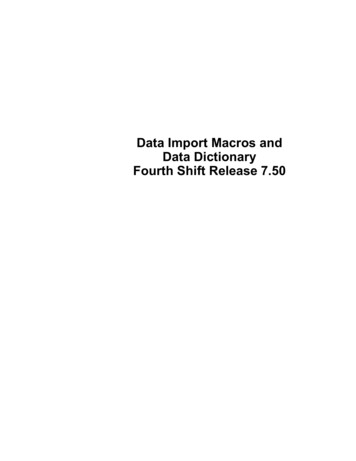
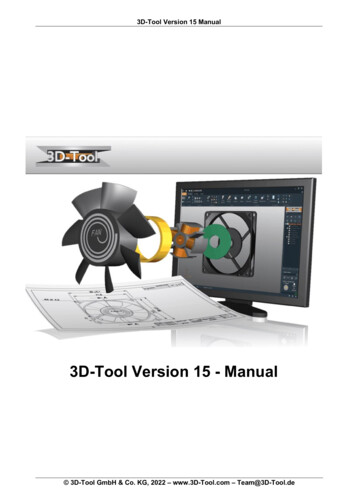
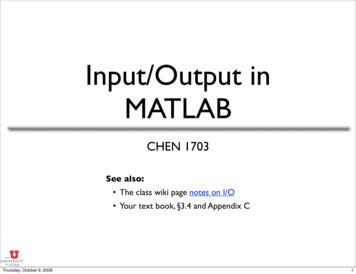
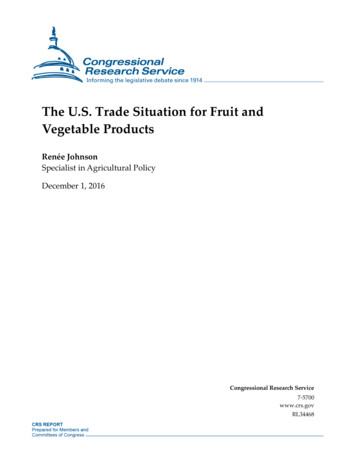
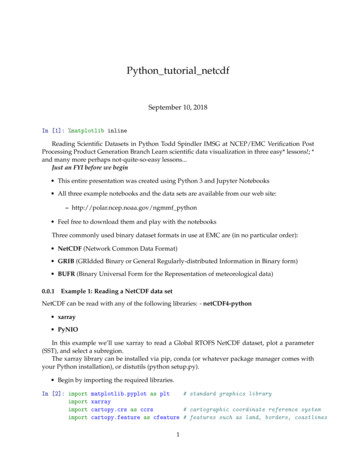
![Lab 006-007 - [NEW] Matlab Data Analysis and Toolbox](/img/25/lab-006-007-new-matlab-data-analysis-and-toolbox-simulink.jpg)
